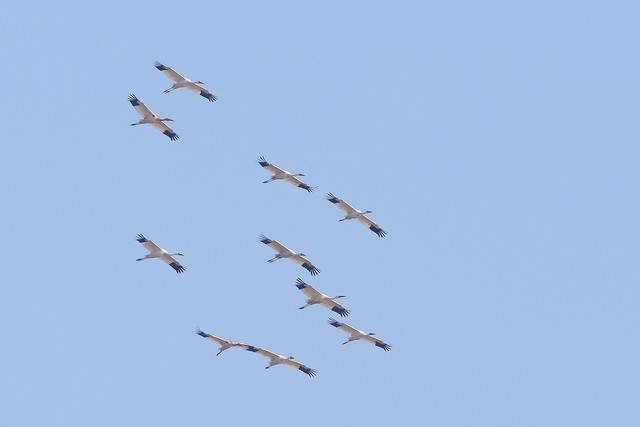Mongolia has some fantastic birdlife. This is hardly surprising, given its vast unspoilt habitats: the Manchurian Steppe, one of the largest natural grassland systems on the planet and resonant with the displays of larks and cranes; the lofty Siberian mountains, alive with eastern passerines; and the barren Gobi desert, home to a unique biodiversity within one of the planet's most hostile climates.
The seasons are short, but each has its own attractions. After the long inhospitable winter, spring (May and June) sees the northward passage of migrants to Siberia while summer (mid-June to early August) provides a narrow window for specialist breeders. By mid-August, migrants are once again heading south to the wintering quarters in South-east Asia.
Globally threatened birds include Swan Goose, Relict Gull and Red-crowned Crane, but top of the list is the critically endangered Siberian Crane, which occurs on migration. In fact Mongolia is perhaps the best place on earth for crane diversity.
A typical two-week late spring or early autumn birding trip to Mongolia should produce around 200-240 species depending on your itinerary. By using Ulaanbaatar as a base you can make short trips to areas such as Terelj, a fantastic mountainous national park only 50 km north-east of the capital. Breeding species here include Grey Nightjar, Thick-billed Warbler, Red-throated and Eye-browed Thrushes, Pallas's Warbler, Siberian Stonechat, Pine and Yellow-breasted Buntings, Brown Shrike and Siberian Rubythroat. This could then be combined with a longer stay at Choibalsan in the far eastern province of Dornod, where you can find some of the charismatic eastern breeding species, including Upland Buzzard, Pied Harrier, Saker Falcon, Amur Falcon, Demoiselle Crane, Oriental Plover, Mongolian Lark, Pallas' Grasshopper Warbler, Pallas' Reed Bunting, Chinese Bush Warbler, Reed Parrotbill, Blyth's Pipit and the recently discovered Ochre-rumped Bunting.
Birding in Mongolia is raw and exciting, with new discoveries just waiting to happen.
Text from World of Birds, Mark Thomas

Siberian Crane © Colin Bradshaw
Showing the 11 Most Recent Trip Reports Posted
Mongolia - A Snow Leopard quest in the ‘wild heart’ of Asia 30th July - 12th August 2022, author Christopher Hall (link created October 8, 2022)
(We watch this magnificent big cat for over 40 minutes until it lies imperiously on a rocky ledge...)
Mongolia: 8th - 16th May 2012, author Jon Hornbuckle (added October 13, 2016)
(Black-billed Capercaillie, Saker,Altai Snowcock, Oriental Plover, Wallcreeper, Henderson's Ground Jay, Azure tit, Hodgson's Bushchat)
Mongolia, August 2005, author Julian Thomas (added November 8, 2005)
(Khan Khentii, Dundgobi Aimag, Gobi Gurvansaikhan N.P and Hustai N.P.)
Khovd - Bird migration in Western Mongolia, author Axel Braunlich (link created May 4, 2007)
(Khovd is a small town at the foot of the Mongolian Altai)
Mongolia with Axel Bräunlich and Nomadic Journeys - June 24 to July 14, 2012, author Paul Jones (added March 3, 2013)
Mongolia: 8 - 16 May 2012 , author Jon Hornbuckle (added July 23, 2012)
(Black-billed Capercaillie, Oriental Plover, Altai Snowcock, Saker, Henderson's Ground Jay, Hodgson's Bushchat, Kozliv's Accentor)
Mongolia - The ‘wild heart’ of Asia - 9th – 22nd June 2017, author Christopher Hall (link created July 2, 2017)
Mongolia, Central Asia and Russia Apr-Aug 2019, author Mark Wood (link created February 24, 2020)
Mongolia - 28th June - 2nd July 2012, author Graham Talbot (link created December 4, 2012)
(The possibility of going to Mongolia to try for my final Snowcock sprang to mind.....)
Mongolia May-June 2005 (definitive version), author Piet Veel (added December 30, 2005)
(gobi desert, Yolyn am, Hustai NP, Jalman, Henderson's Groundjay, Relict Gull, Koslow's Accentor)
Mongolia - 1st to 16th June 2019, author Ian Merrill (link created August 26, 2019)
(Altai Snowcock, Oriental Plover, Asiatic Dowitcher, Amur Falcon, Henderson’s Ground Jay, Mongolian Lark, Chinese Grasshopper Warbler)
No Sightings Have Been Posted for this Region Yet.